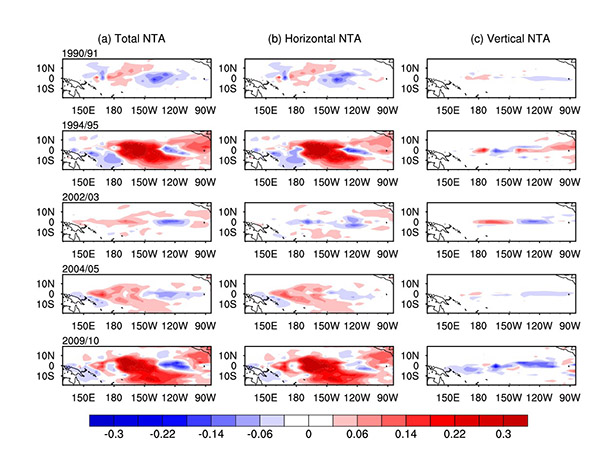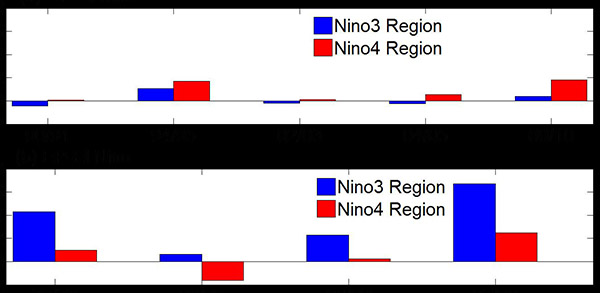State Key Laboratory of Numerical Modeling for Atmospheric Sciences and
Geophysical Fluid Dynamics (LASG)
Institute of Atmospheric Physics, Chinese Academy of Sciences

Vol. 3/No.3 August 2017
Nonlinearity Modulating Intensities and Spatial Structures of Central Pacific and Eastern Pacific El Niño Events
When compared with eastern Pacific (EP) El Niño events, central Pacific (CP) El Niño events are often much weaker and feature patterns with warm centers located much more centrally in the equatorial Pacific. The physics for the difference between EP and CP El Nino still remains controversial. In addition, the dynamical regimes (nonlinear or linearly stochastic) for El Niño-Southern Oscillation (ENSO)are also in debate. The diversities of El Nino may be determined by the dynamical regime of ENSO. Therefore, it is neccessary to study the dynamical regime of ENSO and explore the reason of the diversities of El Nino.
Recently, Prof. DUAN Wansuo, Dr. HUANG Chaoming and Dr. HUI Xu investigated the effect of related nonlinear physical process on the intensities and spatial structures for two types of El Nino events by using the famous Zebiak-Cane model. The Zebiak-Cane model contains both linear and nonlinear temperature advection terms. The nonlinear terms influence the sea surface temperature anomaly (SSTA) associated with El Niño events and therefore also influence the linear terms. This paper compares data from linear and nonlinear versions of the Zebiak-Cane model, as constrained by observed SSTA, in simulations of several CP and EP El Niño events. In particular, the difference between the temperature advection terms (determined by subtracting those of the linear model from those of the nonlinear model), here referred to as the nonlinearly induced temperature advection change (NTA), is analyzed. The results demonstrate that the NTA records warming in the central equatorial Pacific during CP-El Niño events and makes fewer contributions to the structural distinctions of the CP-El Niño, whereas it records warming in the eastern equatorial Pacific during EP-El Niño events and thus significantly promotes EP-El Niño events during El Niño-type selection (Figures 1 and 2). The NTA associated with CP- and EP-El Niño events also varies in its amplitude and is smaller in CP-El Niño events than it is in EP-El Niño events (Figure 3). These results demonstrate that CP-El Niño events are weakly modulated by small intensities of NTA and may therefore be controlled by weak nonlinearity, whereas EP-El Niño events are significantly enhanced by large amplitudes of NTA and are therefore likely to be modulated by relative strong nonlinearity. These data could explain why CP-El Niño events are often weaker than EP-El Niño events. Because values of the NTA associated with CP- and EP-El Niño events differ in their spatial structures and intensities, as well as their roles within different El Niño modes, the diversity of El Niño events may be closely related to changes in the nonlinear characteristics of the tropical Pacific. This conclusion is different from explanations proposed by previous researchers, such as a La Niña-like tropical Pacific, global warming, and westerly wind bursts and may represent a new viewpoint for better understanding the causes of ENSO diversity. In addition, the nonlinear EP El Nino and linear CP El Nino revealed in the present study are helpful for understanding the dynamical regime of ENSO.

Figure1. Spatial structures of (a) the NTA and (b) its horizontal and (c) vertical components in the mature phases of five CP-El Niño events. NTAs are plotted for Jan 1991, Jan 1995, Nov 2002, Jan 2005 and Jan 2010.

Figure2. Spatial structures of (a) NTA and (b) its horizontal and (c) vertical components in the mature phases of four EP-El Niño events. NTAs are plotted for Jan 1972, 1983, 1987 and 1998.

Figure 3. Values of NTA averaged over the Niño-3 and Niño-4 regions in the mature phases. (a) Results of five CP-El Niño events plotted for Jan 1991, Jan 1995, Nov 2002, Jan 2005 and Jan 2010; (b) results of four EP-El Niño events plotted for Jan 1972, 1983, 1987 and 1998.
This study is published in Advances in Atmospheric Sciences (doi: 10.1007/s00376-017-6148-9).
Reference:
Duan Wansuo, Huang Chaoming, Xu Hui, Nonlinearity modulating intensities and spatial structures of Central Pacific- and Eastern Pacific-El Niño events , Adv. Atmos. Sci., 2017. 34,737-756. doi: 10.1007/s00376-017-6148-9.
Contact: DUAN Wansuo, duanws@lasg.iap.ac.cn;
E-mail: lasg_newsletter@lasg.iap.ac.cn
Editors: Chuanyi Wang (wangcy@lasg.iap.ac.cn), Kangjun Chen(ckj@lasg.iap.ac.cn)